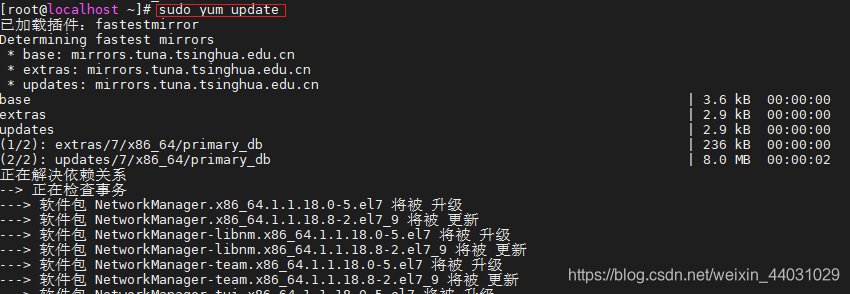Linux下CentOS7系统安装Docker(安装和卸载)
本文共 712 字,大约阅读时间需要 2 分钟。
安装步骤:
-
依据Docker安装规则CentOS系统的内核版本不低于3.10.0使用
uname -r命令查看自己的当前内核版本是否支持安装Docker.
-
更新下自己的yum包:
sudo yum update 按y继续下载
按y继续下载  更新完毕!
更新完毕! 
-
安装需要的软件包:
sudo yum install -y yum-utils device-mapper-persistent-data lvm2
-
设置yum源:
sudo yum-config-manager --add-repo https://download.docker.com/linux/centos/docker-ce.repo

- 查看仓库中docker版本,并选择特定版本进行安装:
yum list docker-ce --showduplicates | sort -r

-
安装docker:
sudo yum install docker-ce-17.12.0.ce

-
启动并设置开启开机启动
sudo systemctl start dockersudo systemctl enable docker
-
验证Docker是否安装成功(有client和service两部分表示docker安装启动都成功了):
docker version
-
查看Docker启动状态:
systemctl status docker
卸载步骤:
-
首先查看docker安装过的包:
yum list installed | grep docker
-
删除安装包:
yum remove docker-ce.x86_64

- 删除镜像,容器,配置文件等:
rm -rf /var/lib/docker
转载地址:http://pehmz.baihongyu.com/
你可能感兴趣的文章
mysql权限
查看>>
mysql条件查询
查看>>
MySQL架构与SQL的执行流程_1
查看>>
MySQL架构与SQL的执行流程_2
查看>>
MySQL架构介绍
查看>>
MySQL架构优化
查看>>
MySQL查看数据库相关信息
查看>>
MySQL查看表结构和表中数据
查看>>
MySQL查询优化:LIMIT 1避免全表扫描
查看>>
MySQL查询优化之索引
查看>>
mysql查询储存过程,函数,触发过程
查看>>
mysql查询总成绩的前3名学生信息
查看>>
MySQL查询报错ERROR:No query specified
查看>>
mysql查询数据库储存数据的占用容量大小
查看>>
MySQL查询数据库所有表名及其注释
查看>>
MySQL查询数据表中数据记录(包括多表查询)
查看>>
MYSQL查询语句优化
查看>>
mysql查询语句能否让一个字段不显示出来_天天写order by,你知道Mysql底层执行原理吗?
查看>>
MySQL死锁套路:一次诡异的批量插入死锁问题分析
查看>>
Mysql死锁问题Deadlock found when trying to get lock;try restarting transaction
查看>>